Perth Activities and Events
The proud capital of Western Australia, Perth is a city of immense advancement and evolution. Nestled on the banks of the beautiful Swan River, the city is bustling with new urban developments which are putting Perth amongst the top travel destinations of the world.
The benefits of the last decade’s resources boom have flowed into every aspect of Perth living with the city experiencing growth in all corners of life. From the brand new Elizabeth Quay to the upcoming opening of the revamped Museum of Western Australia, Perth is becoming home to its very own myriad of engineering feats.
1. Optus Stadium
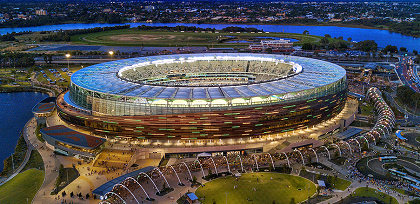
One of the newest additions to Perth’s horizon, Optus Stadium is a multi-purpose 60,000 seat world-class venue. Delivering an exceptional atmosphere and experience no matter the sport, the stadium utilized specialists from Perth, Sydney, Adelaide, Melbourne, Brisbane, Singapore, and London to engineer the sporting marvel.
One of the stadiums’ key features is its climate conditions roof. The stadiums’ structural engineers developed a stunning and efficient roof solution that was made of continuous fabric, free of movement joints, and even integrated with lighting.
It’s no wonder the stadium recently took out the award for the most beautiful sporting facility in the world.
2. RAC Arena
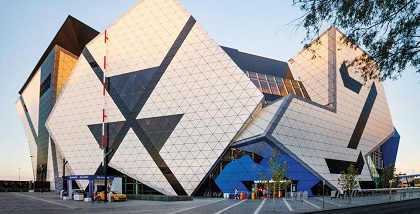
This neo-futuristic entertainment area is found at the heart of Perth's CBD. With its geometric facade, the intense project demanded close collaboration between several teams to bring the arena to life.
With key features including a retractable roof that can open and close in less than 15 minutes, five-level tiered seating and corporate suites, RAC Arena is a unique and wonderfully complex venue to admire from both within and afar.
Since its opening in 2012, approximately 3 million people have visited the Area for 350+ major events.
3. Canning Dam
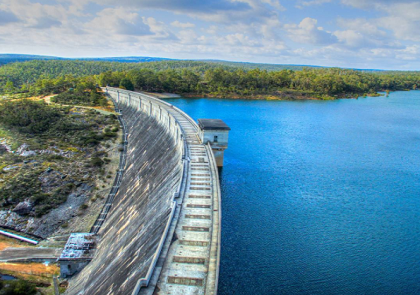
The Canning Dam and reservoir provide a major freshwater resource for Perth. It is well known for its innovative structural and hydraulic design that was at the forefront of concrete gravity dam design at the time of construction in the late 1930s. Inflow into the Canning Reservoir is estimated to be 22 gigalitres and has a storage capacity of 90.352 gigalitres.
Not only is Canning Dam a benchmark site in the history of Perth's development but is an engineering masterpiece of its time, complete with a curved concrete wall and the use of International Stripped Classical detailing on the gatehouse piers.
Did you know that during its constructions, bulk handling of cement was used for the first time in Australia? This was instead of the usage of bagged cement, which was the standard practice of the day.
Did you know that it is open for visitors to walk across during the day? You can even make it a day trip with picnic areas and bushwalking trails surrounding the area.
4. City of Perth Library
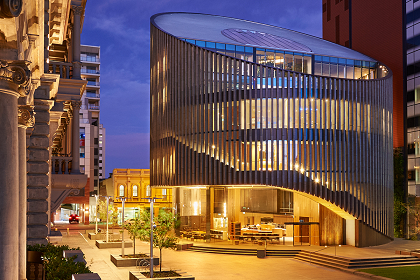
Did you know that the new City of Perth Library is the first major civic building to be built since the Perth Concert Hall nearly 40 years ago?! This magnificent building is revealed across seven levels with authentic ceiling artwork, gardens, and auditorium.
The library has a circular design that is complemented by a series of glass facades and stone-clad columns. The intermittent vertical cladding that decorates the outside of the building is orientated to draw in natural light.
One of the most advanced aspects of the building is its’ built-in mechanical systems. The library features underfloor air distribution through the main library collection levels, forming part of the greater sustainability initiatives for the building.
5. Matagarup Bridge
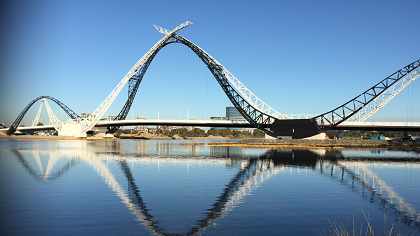
The Matagarup Bridge is a pedestrian bridge crossing over the Swan River. It’s an incredible feat of engineering, design and West Australian workmanship.
The challenge of the construction was the long period of over-water construction. The building of the bridge required parts of the river to be completely closed for more than two months. Transport Minister, Rita Saffioti, said: “This project has been one of the most technically difficult constructions ever undertaken in Western Australia and the local workforce has embraced the challenge and done an outstanding job.”
Designed to look like two flying swans, the bridge is now a symbol of innovation along the Perth city skyline and is a spectacular gateway to the new Optus Stadium.
6. Mills Park
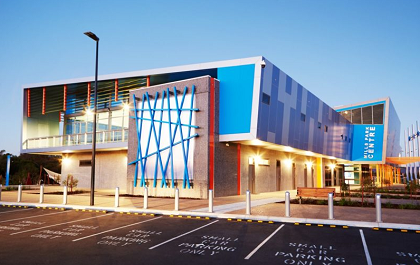
Did you know that in suburban Perth, a team of engineers has been setting Australian-first standards for environmentally friendly projects? The Mills Park Centre in Gosnells is the first as-built rated 6 Star Green Star public building in Australia.
This mixed-use community facility has multiple environmentally-friendly features, including carbon-friendly materials and the inclusion of Bubbledeck, a construction approach that requires less structural support and building materials overall.
The city’s Director of Infrastructure, Dave Harris says the project has exceeded all initial expectations.
“Our administration building was the first five-star green star public building in WA and now Mills Park is the first six-star green star designation for a public building for both design and construction in Australia, I really couldn’t have planned for anything better.”
7. Western Australia Museum 2020 and Central Energy Plan
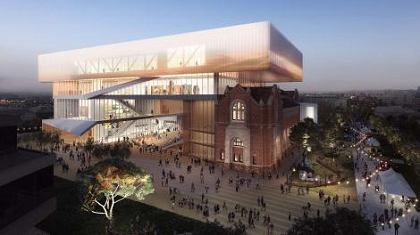
Cutting-edge technology is currently being used to redevelop the Western Australia Museum, which finds its home in the Perth Cultural Centre. The $359.9 million project will be nearly four times the size of its predecessor. It will also encompass a $17.1 million research centre.
The project is a mammoth task for engineers. Challenges have included the restoration of four heritage buildings which made up part of the previous museum and meeting the need to heavily load the new museum’s cores to the equivalent of a 30-story building.
The construction is also including a Central Energy Plant which will service the entirety of the Perth Cultural Centre. It will reduce energy use and Co2 emissions in the Perth Cultural Centre by 30-40% by 2020.
Whilst it can be tempting to rush home and into bed as fast as possible on Perth’s gloomy wintry days, the cooler months are the perfect time of year to explore our bustling city, just without the bustle!
Perth comes alive in winter, from film and art festivals to pop-up bars and ice skating in the city centre, there is never a shortage of new things to try. Here is a list of activities that we are sure will keep your body temperature up this winter.
Ice-skating at Elizabeth Quay
It’s back by popular demand for the third year in a row! From 28 June to 21 July, Perth’s pop-up skating rink is open to people of any skill level and is conveniently located in the city centre at Elizabeth Quay. With world-class entertainment, music performances, rides and food trucks, there is no better way to spend your winter nights than on the ice.
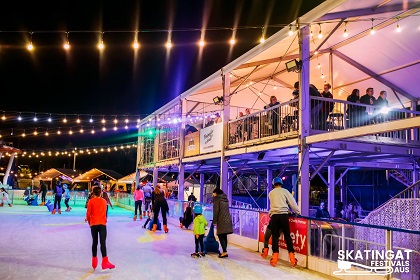
It can get pretty busy so we recommend buying tickets online to secure your spot.
Explore Northbridge
Rug up in your best scarf and coat and get ready to explore the kaleidoscope of food, arts and nightlife in Northbridge. Commonly referred to as the ‘cultural hub’ of Perth, Northbridge is bursting with things to eat, drink and watch. We recommend checking out Lucky Chan’s Laundry + Noodle Bar, where their spicy bowls of soup are sure to keep you warm on a cold night.
Northbridge is highly accessible with Perth busport and train stations nearby. Take a look at their menu.
Explore the ocean with AQWA
Winter isn’t great beach weather, however, we can do you one better. At the Aquarium of Western Australia (AQWA), you are able to get up close and personal with the beautiful marine species of Western Australia. With exclusive adults-only evening events, one of the world’s largest living coral reef exhibits and a 98 meter long moving walkway, plan your next day trip to this oceanic marvel.
Find out more and book tickets.
Experience the theatre at the State Theatre Centre of Western Australia
Housing the Heath Ledger Theatre, this 575 capacity building is a defining architectural landmark in the city of Perth. The Centre is consistently busy hosting events ranging from theatre to dance and music performances that feature both local and global talent. With brand new world-class facilities, there is no better way to spend a special evening.
Check out their schedule and book tickets on their website.
Take your sporting skills indoors
The rain is no excuse to stop getting active this winter. Perth is home to an endless number of indoor games and activities. From mini golf and bowling to trampolining and rock climbing, there is something for everyone. We recommend checking out Holey Moley, Perth’s craziest and most unique mini golf venue. Test your skills against the infamous windmill and ‘shark infested’ waters.
Find out more today.
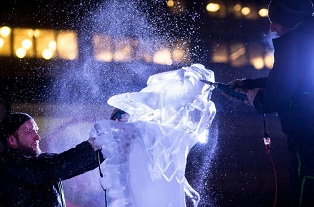
Embrace the cold at Winter Fest
The city is guaranteed to light up this year with Winter Fest. Running from 24 June to 21 July, this myriad of events will be heating up your social calendar. From incredible light showers, delicious comfort food, magicians and a pop-up cinema there is almost too much to choose from.
Check out the full list of happenings.
Fremantle Markets
One of the leading tourist destinations in WA, the Fremantle Markets is something you just can’t miss this winter. With an incredible of sights, smells and sounds to take in, there is something for everyone within the array of local talent the market showcases. Buy the latest piece of hand-made clothing or treat yourself to a piece of cake and coffee. Fremantle Markets is alive with culture and a great way to spend a winter weekend.
Go for a drive outside of the city
It takes less than an hour’s drive to escape the city and be amongst the rolling Perth hills. With beautiful stretches of road, valleys, trees and lookouts, a winters drive through the country is the perfect escape during a wintry weekend. With the recent rainfall, the city has endured, we recommend checking out Bells Rapids. This beautiful picnic and bushwalking spot is home to white water rapids which thrive during the winter season.
Find out all you need to make it a day trip.
Art gallery
Located in the heart of the Perth Cultural Centre, the Art Gallery of Western Australia is a peaceful and serene escape to the busy nature of the city. The Collection, associated programs and stimulating exhibitions offer Gallery visitors a unique and exciting experience of historic and contemporary Australian artists. The gallery is also in close proximity to a number of cafes to rest and enjoy lunch at.
Kings Park
One of the largest inner city parks in the world and visited by an astonishing 6 million people each year, Kings Park is an outstanding collection of Western Australian flora and an ideal place for picnics and walks. With stunning views of the city and surrounding areas, it’s ideal for a winter’s drive and a great spot to get your next Instagram photo of storm clouds rolling in.
BP’s Kwinana Oil Refinery in Western Australia is the largest refinery in the country, producing 8300 megalitres of oil per year. Crude oil is shipped in from the Middle East, West Africa, New Zealand, Indonesia and north-west Australia. This refinery provides all the fuel to transportation vehicles in Perth and the South West — including petrol, diesel and jet fuel. Fuel is also shipped to South Australia and Tasmania.
The Anglo-Iranian Oil Company was looking for another location for a refinery after their Abadan refinery was closed in 1951. After a restructuring of the company, they decided to move away from being dependent on a single refinery and instead decided to construct a spread of refineries internationally. One of the places they decided to build a refinery was in Australia.

The site of the refinery was chosen after the company became dejected when they couldn’t find a suitable site on the east coast. Sir Russell Dumas and David Brand from the Works for Western Australian Government travelled to Melbourne to meet with the Anglo-Iranian delegation, after Dumas realised the Cockburn Sound was a suitable location. Given it had a harbour facility, plenty of available land and a calm climate, the delegates headed to Perth to visit the site. The decision was finalised in January 1952 and construction began in the following year.
In December 1954, the Anglo-Iranian Oil Company’s name was changed to the British Petroleum (BP) Company, after vote by shareholders.
Finished in 1955, this project was considered significant by Engineers Australia because of the positive economic and social impact it had on Western Australia. One of these impacts was the development of a township a few kilometres inland of the refinery to accommodate workers on the site. The State Housing Commission built 1000 houses in the area over a three-year period, creating a community in the area.
This refinery was the first major industrial plant established in Kwinana, and was the catalyst for the area’s substantial growth. Not only did it lead to the establishment of the industrial area, but also to the development of the harbour at Cockburn Sound.
The refinery has signed an agreement with the Western Australian Government to continue operating until 2050.
If you’re brave enough to face the cold in the early hours of Saturday morning, you’ll be able to witness the longest lunar eclipse of the 21st Century.
The moon will be joined by Mars, which will be at its brightest and closest to Earth in 15 years according to Dr Tanya Hill, an astronomer from Melbourne Planetarium.
“The reason that Mars can vary in brightness so much is because it’s our neighbour in space and it follows quite an elliptical orbit. Throughout 2017, Mars was fairly dull as it was on the opposite side of the Sun to Earth, and therefore at its most distant,” she said.
“But even at each opposition the distance between Earth and Mars can vary by almost 50 million km, because of the two planets’ elliptical orbits. 2018 is definitely one of the best.”
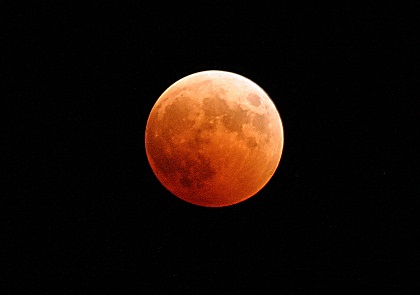
People in Western Australia will be lucky enough to witness the full eclipse.
“Western Australia will be the only state to catch the entire eclipse. It will begin with the Moon high in the northwest and end with the Moon low to the western horizon,” she said.
“For the rest of Australia, the eclipse will begin with the Moon in the western sky and the Moon will set as the eclipse progresses. As the Moon sets, the Sun will rise so the later part of the eclipse will occur against the brightening dawn sky.”
It’s expected to begin at 2:24am Australian Western Standard Time and to end at 6:19am on July 28. The period of totality refers to the Earth’s shadow being directly across the moon, making it appear at its reddest. Dr Hill says this period is expected to last exactly 1 hour, 42 minutes and 57 seconds. This is just 4 minutes shorter than the longest possible eclipse.
“Three things have come together to make this possible,” said Dr Hill.
“First, and most importantly, this eclipse will see the Moon move through the centre of Earth’s shadow, making for a long and deep eclipse.
“Second, the eclipse occurs during an “apogee” Moon, when the Moon is at its most distant from Earth.
“For those who remember Kepler’s Second Law, being at its most distant means that the Moon is moving at its slowest. Therefore, it will spend 5-10 minutes longer in Earth’s shadow compared with a perigee Moon, when the Moon is at its closest approach to Earth and moving more rapidly.
“Finally, an extra few minutes are picked up because this eclipse is occurring near aphelion, which is when Earth is furthest from the Sun and occurs in early July.”
Across the world, everyone who is on the night side of the world will experience the eclipse at the same time. Central Asia and Eastern Africa will have full visibility throughout the event. Western Africa, Eastern Asia, South America and Europe will have partial visibility. The only places that won’t be able to see it are North America and the Arctic.
It’s completely safe to watch a lunar eclipse and no special equipment is required, according to Dr Hill.
Before the submarine telegraph cable was first laid between Java and Port Darwin in 1872, Australia’s only communication with the outside world happened via letter carried by ships from overseas. This meant it took months for any news to arrive. 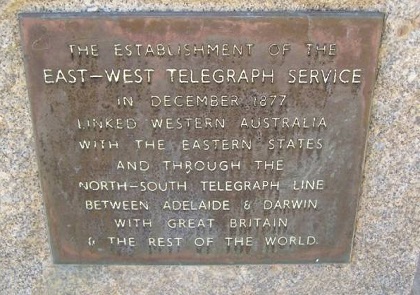
Australia was behind the rest of the world when it came to the installation of the telegraph line. The first telegraph message in the world was sent via Morse code in 1844; however the first line in Australia wasn’t constructed until 1854. This linked Melbourne to Victorian port Williamstown and was extended to Geelong later that year. Lines continued to be built throughout the state until there was a widespread network by 1857.
Telegraph lines connected both South Australia and New South Wales to Victoria by 1858. Tasmania was connected to Victoria in 1859. In 1861, a line was constructed to link Queensland to New South Wales, which meant the eastern states were all in communication with each other. The Overland Telegraph was completed in 1872 and linked the eastern states to Java via Darwin, which allowed them to receive international news.
Construction of the East-West Telegraph Line
Western Australia’s first telegraph line connected Perth and Fremantle in 1869. Often mail steamers would first arrive at the port in Albany, so a conveyance link to Perth made a lot of commercial sense. This line was completed in 1872. However, the state wasn’t connected to the rest of the country until the East-West Telegraph was constructed in 1877.
The idea of a line between South Australia and Western Australia was discussed as early as 1860, however no decisions were made. In 1873, the South Australian government received a proposal from the Western Australian government. Originally the proposal was rejected as South Australia didn’t feel they were getting enough out of the deal to allocate funds to it. The next year it was accepted by Charles Todd, their Superintendent of Telegraphs, as he decided it was necessary to their trade and commerce, navigation and defence. Both states passed bills approving the cost of the telegraph line’s construction.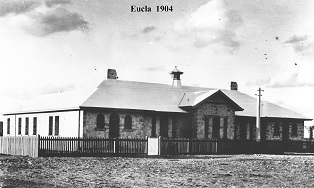
The line was originally going to stretch from Eucla in South Australia to Albany in Western Australia. In 1866, a telegraph office was established at Port Augusta, as this was a staging post for the Overland Telegraph. It was the decided the East-West Telegraph line would stretch the 3310 km from Port Augusta to Albany.
This would be the toughest public works the small Western Australian colony had ever carried out, particularly because one third of their section had no European inhabitants. Therefore, a lot of the terrain was unknown. The construction was split into multiple sections, to make the project more manageable. The poles were made from Jarrah wood rather than iron as it was less likely to corrode and require frequent maintenance.
In January 1875 the first pole was planted in Albany. In August of that same year, the first pole was planted in Port Augusta. The South Australian section of port Augusta to Eucla was completed in July 1877 — the Western Australian section was completed that December, and the first telegraph message was received in Perth.
Engineers Australia considers this project to be significant due to the harsh conditions faced during construction; given it was completed using commercially available technology rather than innovative techniques. It was also important as a commercial link when the gold rush began in the 1890s. In fact in 1896 the link was extended to reach Coolgardie which was part of the goldfields. It was also an integral part of laying the foundation for Federation in Australia.
The Canning Dam is a popular tourist attraction in Perth. The stunning scenery makes it the perfect picnic spot, and there are a number of different walks visitors can complete in the area. These range from short strolls, to longer hikes — look out for the signs that explain the historical significance of the area. There is even a wide path along the dam wall, which means you can take in the view of water on one side and dry land on the other. Engineers Australia have marked this feat of civil engineering as historically important, as it solved the major water shortages the Perth metropolitan area was suffering from in the late 1800s and early 1900s. It has also been recognised by the Heritage Council of WA for its innovation and technical excellence.
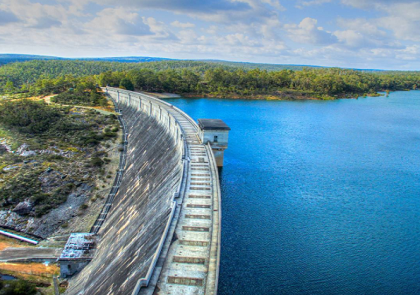
Historical Significance of the Dam
The Canning Dam was the primary water supply to the Perth metropolitan area, from its completion in 1940 until 1961 — the Serpentine Dam was built to keep up with the population growth. It currently supplies approximately 20% of the water to the current metropolitan area.
The City of Perth Waterworks Company launched the first reticulated water supply in October 1891. However, this was quickly overshadowed by angry ratepayers and members of the Perth City Council, who were upset about the company’s handling of reticulation and house connections.
There were also a number of deeper issues, such as rapid population growth due to the gold rush, which had already rendered the scheme inadequate. It was also only relevant to Perth; with Midland Junction, Claremont and Fremantle not receiving service for another 15 years. This meant much of the population was excluded from the water supply. At the same time, there was an outbreak of typhoid and waste disposal was considered basic and underdeveloped.
The Government had made the water company the responsibility of local council, which meant it was originally reluctant to become involved in any issues. However, by 1986 the Government had resorted to setting up the Metropolitan Water Works Board. This Board first proposed the construction of a dam on the Canning River in 1897, however funds were not allocated to the project.
In 1924, a pipehead dam was built near Araluen and used the Canning River as its water source. This was launched by Premier Sir James Mitchell, to satisfy the constant water shortages in Perth. However, the water supply was still insufficient for the population and the quality was poor.
In the meantime, several reports from inquiries had recommended the construction of a dam on the Canning River. Despite this, and multiple droughts, the Government didn’t allocate any funds to the project until the early 1930s.
Construction on the dam began in 1933 and it was completed in 1940. It’s considered to be of social significance for a number of reasons. Firstly, it provided a number of employment opportunities during the Depression, which helped the labour market recover. Since it was so labour intensive, many people in Perth were associated with it and formed a community. It has also been an enjoyable day trip for generations of Australians, who have enjoyed the surrounding landscapes.
It has also been recognised for its aesthetic structural design, given it had minimal environmental impact and features a curved design which demonstrated technical excellence. On top of this, it is still mainly in its original form. It was the first instance new concrete batching technology in Western Australia and was a benchmark for hydraulic technology at the time.
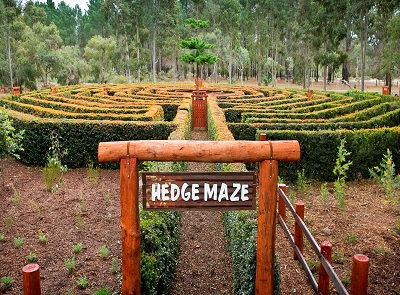
There are a number of fun activities to do in Perth, such as laser tag, rock climbing and super golf. Here are some of our favourites.
Latitude
This indoor aerial super park features over 100 interconnected Olympic-grade trampolines, where you can show off your backflips and other acrobatic tricks or just enjoy bouncing around.There are also a number of aerial activities, such as pink stepping poles and a high ropes course. Don’t forget to try out the rock climbing and abseiling as well! You can find Latitude in Edgewater.
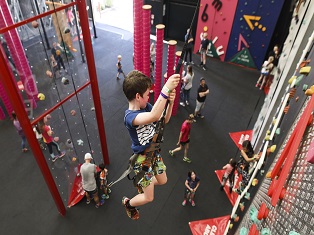
Lazer Blaze
If heights and acrobatics aren’t your thing – don’t worry. Why not try out a game of laser tag? Lazer Blaze runs Super Sessions for adults on Friday and Saturday nights. This consists of a variety of 10 minute mini-games. They also offer 90 minute games of laser tag during the week. They’re located in Willeton, Port Kennedy and Malaga.
The Maze
There are seven different mazes in this one location! Some of them are traditional and require you to find your way into the centre and then back out again. Others are brainteasers and have extra rules in place. While you’re here, you might as well play a game of mini-golf too.
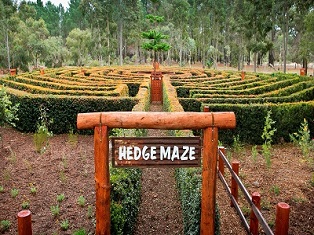
If you’re keen on wildlife, there’s also the opportunity to see koalas, wombats, emus and kangaroos. From September to April, there’s also a water park – get your heart racing on the three-storey high waterslides! The Maze is located in Bullsbrook.
SUPA Golf
This modified version of golf features golf clubs with oversized heads and giant golf balls, made of rubber plastic. These adaptations make it much easier to play. Visitors have the option of playing 9 or 18-holes of golf. Why not make a day of it and enjoy a game of Adventure Putt Miniature Golf? It’s just like regular mini-golf, only set in a jungle oasis amongst beautiful gardens and water features. SUPA Golf is located in the Swan Valley.
Did you now an interactive LEGO brick exhibition has arrived in Perth?
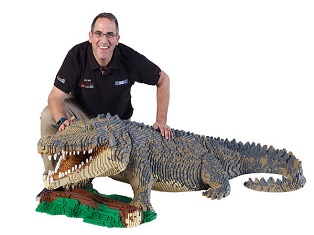
That’s right, Brickman Awesome will be showcasing the tallest LEGO model in the Southern Hemisphere — a NASA SLS rocket, which was constructed using more than 450,000 bricks and measures in at 7.5 metres tall. It took exhibition curator Ryan McNaught more than 500 hours to build the model and it even features a lighting display which creates the illusion that the rocket is blasting off into space.
The exhibition also features a life-sized Toyota Camry, the only life-sized LEGO Harley Davidson motorbike ever built and the world’s largest LEGO Caterpillar 797 dump truck. For the science-fiction fans, there is a life-sized TARDIS from Doctor Who and a light-up Back to the Future DeLorean. A full-sized Australian saltwater crocodile, weighing 60 kilograms and comprising of 40,000 LEGO bricks is also on display. Don’t forget to check out the LEGO Kangaroo, Koala and Orca too!
In total, there will be 38 brand new LEGO models, which have been created using more than 2 million bricks and took the team more than 5000 hours to construct. Ryan McNaughton is the only LEGO Certified Professional in the Southern Hemisphere and one of only 14 in the entire world!
Visitors also have a chance to show off their building skills. There’s the opportunity to help the Brickman team expand their colony of Emperor Penguins. You can also build your own time machine and contribute to Australia’s longest LEGO model, by adding new sections to the snake!
This event is being held at the Perth Convention Centre until July 22.
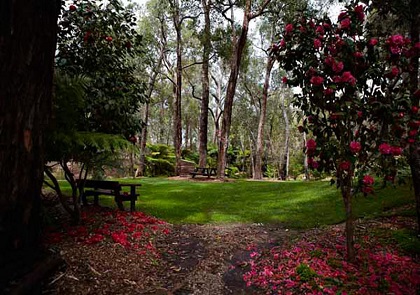
Perth is surrounded by some amazing destinations that are only a couple of hours out of the city. If you’re looking for something to do during your study-break or on the weekend, why not explore some more of Western Australia? Here are some of our favourite day trips.
Araluen Botanic Park
This stunning park is home to 59 hectares of native Australian bushland and 14 hectares of manicured gardens showcasing exotic plants. In the spring, it features more than 100,000 tulips in full bloom against a backdrop of eucalyptus trees. Visitors can take a train ride around the park to take in the scenery and learn about Western Australia’s native flora. Located in Roleystone, it is only 35km south-east of the Perth CBD.
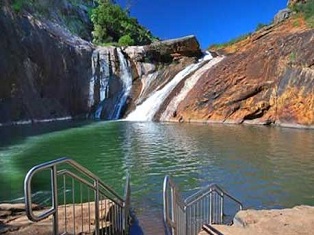
Yanchep
This is the perfect place to spot koalas and kangaroos in their natural environments. There are also a number of walking trails, where you can relax and take in the beautiful scenery. If you’re looking for something a bit more adventurous, why not visit one of the natural caves?
Gnomesville
Thousands of gnomes live amongst some trees on the side of the road, approximately 195km from the Perth CBD. How Gnomesville originally came into existence is still a mystery; however some people believe one gnome was placed there on its own and then others were added to keep it company. Since then it has become an attraction for both tourists and Perth locals, with visitors from all over the world adding to the community.
Serpentine Falls
Best visited in winter, you can watch the water from the Serpentine river cascade down a granite cliff here. Why not pack a picnic and enjoy lunch surrounded by grey kangaroos? There are also a number of hiking trails in the area that can take from 15 minutes to five hours to complete, depending on how far you want to walk. The falls are located in the Serpentine National Park, which is 55km south-east of the Perth CBD.
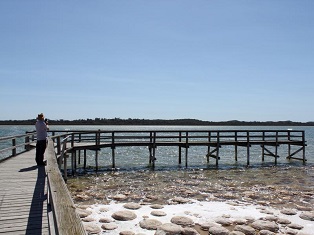
The Pinnacles
Thousands of natural limestone sculptures cover this dessert. Known as the Pinnacles, they can stand up to 5m tall. The best time to visit is at dusk or dawn as the shadows cast by these formations create incredible shapes and patterns across the sand. You might even be lucky enough to spot a wild emu.
Lake Clifton
This lake is home to thousands of thrombolites, which are tiny micro-organisms believed to be some of the earliest life-forms on earth. Follow the boardwalk to get an aerial view of these creatures. They resemble rocks, despite the fact that they’re actually alive. Located in the Peel region, it’s only a short drive from Mandurah and Bunbury if you’d like to continue exploring the state further.
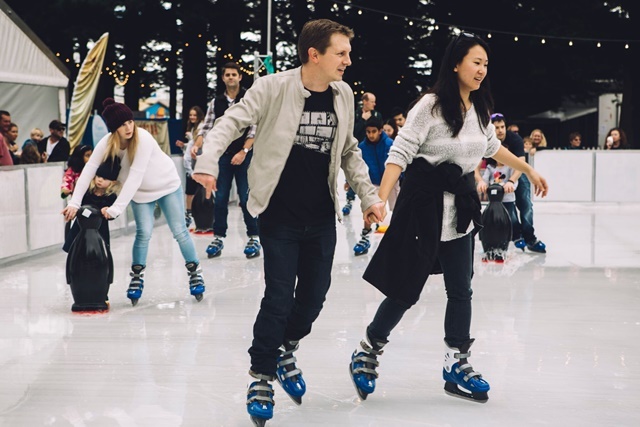
This winter, get your skates on and brave the cold at winter wonderland events in Fremantle and Elizabeth Quay. If you’re not too keen on ice skating, there will be snow-man building, inflatable slides,
food stalls and markets.
Winterworld
This outdoor ice skating rink in Fremantle will be complete with falling snow. There will also be a giant inflatable slide and a snow pit, where you can build your own snowman. If you’re feeling cold, don’t worry — inside the National Hotel is a warm and cosy Cabin Bar. You can relax here with a warm hot chocolate, roast marshmallows around a fire pit, or visit local producers and retailers showcasing their wares at the marketplace. There will also be food trucks serving food, perfect for a cold winter’s day.
Australia’s largest open-air ice skating rink will be open from 23 June – 15 July at the Fremantle Esplanade Park.
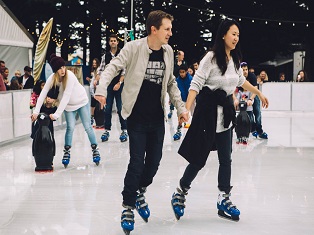
Skating At Festival
This open-air ice skating rink is located in the heart of the city at the picturesque Elizabeth Quay. The pop-up rink is ideal for people of all ages and skating abilities. If you’re looking for a dose of adrenaline, you can race your friends down a slope on a snow tube. There will also be a giant inflatable slide and a bouncy castle, plus food trucks selling snacks and hot drinks.
This attraction will also be open from 23 June – 15 July at Elizabeth Quay.
While Perth is known for its beaches, wildlife and hiking trails, the cold and wet weather doesn’t always make these activities seem so appealing. So, we’ve come up with a list of things to do which will keep you warm and dry this winter.
AQWA
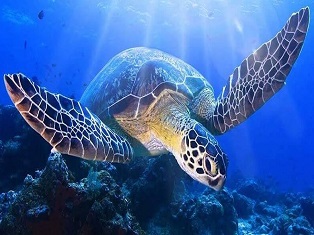
The Aquarium of Western Australia is passionate about generating respect for marine life through their education programs, rehabilitation of sick and injured animals and conservation efforts. Their exhibits feature marine life from five different zones: the great southern, shipwreck coast, Perth coast, the far north and the danger zone. These include one of the world’s largest living coral reefs, fish, sharks, rays and turtles. It also features Australia’s largest walk-through aquarium tunnel.
There are a number of experiences on offer at AQWA as well. These include diving, snorkelling and behind the scenes tours.
AQWA is located at Hillarys Boat Harbour, approximately 20 minutes north of the Perth CBD.
Perth Mint
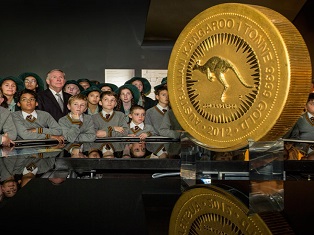
The Perth Mint was opened in 1899 in response to the discovery of gold deposits in Kalgoorlie and Coolgardie. It was used for gold refining up until
The Gold Exhibition tells the story of the search for gold in Western Australia through a series of photographs, artefacts, multimedia presentations and gold mining legends. Meanwhile, you can also watch a traditional gold pour in the original 1899 melting house, during which the molten gold transforms into a solid bar.
Another major attraction is the Guinness World Record-holding Australian Kangaroo One Tonne Gold Coin. This is the world’s largest and most valuable coin, made out of 99.99% pure gold and measuring 80 cm wide by 13 cm deep.
Girls School Cinema
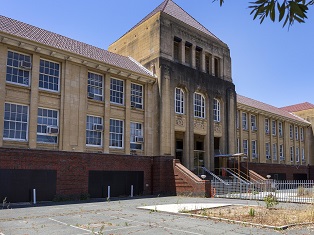
The people behind Fringe Festival and Rooftop Movies are opening a new pop-up cinema this winter, and it will be showing a combination of blockbuster, classic and arthouse films. Located in one of Perth’s most beautiful buildings atop the highest part of East Perth, it was formerly a girl’s school and police station. The castle-like structure is iconic for its Egyptian Art-Deco grandeur.
Just like at Rooftop Movies there will be plenty of food trucks, this time offering up foods perfect for winter including toasties, soups and popcorn.
The Swan River Colony was settled in 1829, and in its first 60 years Western Australia made little progress. In 1881 the state had a population of less than 30,000 people, however by 1911 the
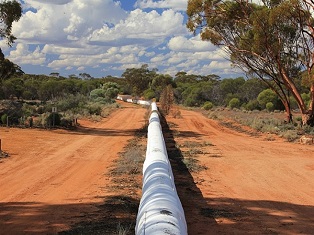
population had grown to 282,000. This was a result of the gold mining in the eastern “desert” from 1893, which drew people from across Australia and the rest of the world. The scarcity of water in the Goldfields area caused many deaths and the rapid spread of disease, so the government decided they needed to implement a scheme to address this problem.
Western Australia’s Engineer-in-Chief C. Y. O’Connor proposed the construction of a 30 metre high dam, 521 kilometres of steel pipeline and 8 steam-driven pump stations with associated reservoirs. He was met with criticism due to the cost of the project and the fact that many people believed this plan wouldn’t work. However, construction of the Mundaring Weir and Coolgardie Pipeline still went ahead.
One of the reasons this project was considered significant by Engineers Australia was because the construction occurred during a time when Western Australia lacked its own resources. This meant the cement, steel and machinery had to be imported from Europe and timber had to come from the United States. As a result, it took between six weeks and three months for the materials to arrive. Despite this, it took just under five years for the project to be completed. This was due to the successful leadership of those directing the construction and the large workforce who contributed.
There were also no tertiary or technical education facilities in the state at the time; however those working on the construction of the pipeline utilised innovative technologies. For example, this construction developed the practice of using thin-walled steel pipes to deliver water to remote areas with arid conditions, typical of Australia.
On completion, the dam was the largest in the southern hemisphere and the pipeline’s length was unprecedented. The project ensured the viability of the settlement in the Goldfields area by providing a reliable water supply. This greatly boosted the development of Western Australia.
Today, the Mundaring Weir is still in use and located in the Darling Ranges escarpment. It’s a popular picnic spot and close to natural hiking trails in the surrounding Perth Hills.
Perth is home to many natural attractions, including bush walks, beaches and waterfalls. Here are some of the top places you can visit for free.
Kings Park and Botanic Garden
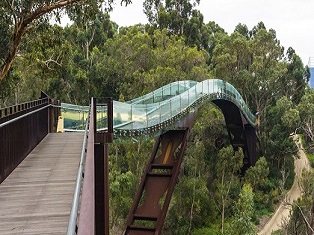
This is one of the largest inner city parks in the world, boasting a total area of 400.6 hectares. The landscape is made up of a combination of cultivated gardens and natural bushland, featuring 319 species of native plants and approximately 80 bird species. There are a number of attractions you can enjoy at Kings Park , such as taking a guided tour to learn more about the area, or following one of the trails. The Lotterywest Federation Walkway takes visitors through the botanic gardens and up into a canopy of trees. The trail begins at ground level and then travels up into a glass and steel footbridge, with a maximum height of 16 metres. It offers a panoramic view of the city and the native flora throughout the park.
The park also features a number of places which honour Indigenous culture , such as the Aboriginal Art Gallery, the Beedawong amphitheatre and the Boodja Gnarning Walk. There are also a number of memorials and honour avenues —the most famous one is the State War Memorial Cenotaph, which attracts over 40,000 people for the annual ANZAC Day Dawn Service.
Free City Walking Tours
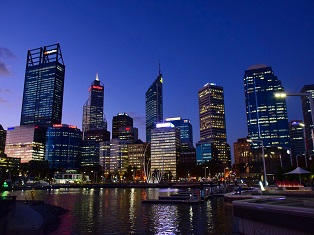
These walking tours are helpful for people who are new to the city and looking for an orientation, or those who would like to learn more about the history, arts and culture in Perth. The iCity Information Kiosk is located in the Murray Street Mall and the volunteers are available to provide visitors with information about events, activities and attractions. They also offer brochures for self-guided tours.
Stirling Gardens
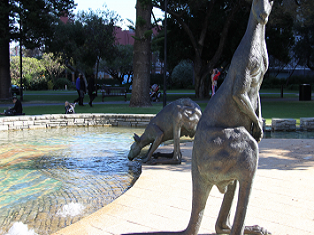
When the Swan River Colony had first settled, this spot was established as an acclimatisation garden, where plants were raised from seeds. This included grapes and other fruits. In 1845 it was opened as a botanical garden and some of the original trees still remain here today. It underwent reconstruction work in 1965, to add a retaining wall and shallow pools of water. It’s now the oldest public garden in Perth and features a number of artworks and sculptures.
Bells Rapids
This natural attraction is located in Brigadoon in the Swan Valley and features picnic areas and bush walking trails alongside streams and waterfalls. It’s also a prime location to watch the annual Avon Descent White Water Race, although swimming is not permitted in the area. The grey kangaroo can be spotted here at certain times of the year.
Lesmurdie Falls
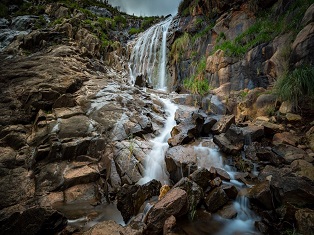
This waterfall is located in the Lesmurdie National Park in the Perth Hills and is considered to be one of the most spectacular features of the Darling Ranges escarpment. The trail begins at the top of the falls and can be followed down to the base, where there is lush vegetation and a picnic area. At the top of the falls there is a lookout, so you can get a perfect view of the area. The trail is considered moderate in difficulty and is approximately 2 kilometres long.
Mount Dale Walk Trail
This 2.5 kilometre trail allows hikers to walk up to Mount Dale’s peak, so they can get panoramic views of the Darling Ranges in the Perth Hills and experience the beauty of the natural jarrah forest. The circular walkway goes up through bushland to the lookout, before meeting up with the Bibbulmun Track upon descent. It is considered to be of moderate difficulty.
Visit one of Perth’s Beaches
Perth is known for its sunny weather and beautiful coastline, so why not visit one of the many beaches? There are fantastic beaches from Fremantle to Burns Beach, however the most popular are Cottesloe, Trigg, Scarborough, Leighton and City Beach.
Swan River Loop
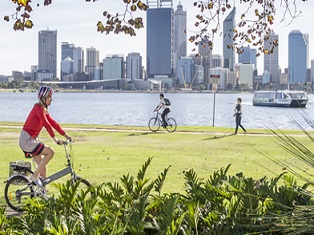
Cycle around the Swan River and take in the sights of Elizabeth Quay, Barrack Street Jetty and the South Perth Foreshore. This is a great way to see Perth city and enjoy the outdoors at the same time. The pathway is considered easy and can even be completed on foot. Remember, it’s compulsory to wear a helmet if you do cycle.
Sunset Coast Cycleway
A 14 kilometre cycleway follows Perth’s stunning coastline from Marmion to Burns Beach. This half-day cycle takes you past highlights including the Marmion Marine Park, Hillarys Marina and Mullaloo Beach. You can also walk or jog sections of the path.
The port city of Fremantle is located approximately 25 minutes from Perth’s CBD and has played a large part in Western Australia’s history. In 1829, Captain Charles Fremantle claimed the West Coast of Australia under the British Crown. That same year, the first British settlers arrived on the shores of the Swan River and began to establish a colony, led by Governor James Stirling.
The Swan River Colony was unique, because it was built by free-settlers — civilians and military — rather than convicts. However, the colony struggled and manpower was needed to build the infrastructure required to ensure its success. As a result, convicts were sent to Western Australia from 1842 and constructed some of Fremantle’s most distinguished heritage buildings, including Fremantle Prison and Fremantle Arts Centre. During this time, the colony expanded 20 kilometres from Fremantle to Perth. Fremantle is also home to two of Western Australia’s most impressive engineering feats : the Stirling Bridge and the Fremantle Harbour.
The Stirling Bridge
Since the colony’s inception, a key focus was on building a bridge over the Swan River to connect Fremantle and the Perth township. Without one, the only way to cross between the two banks was by ferry. The first bridge was built out of timber by convicts in 1867 and named the North Fremantle Bridge, which was later changed to the High Level Bridge.
The first stage of the Eastern Railway was constructed in 1881, linking Guildford and Fremantle. As part of this project, a railway bridge was built in 1880. It was built with much stronger timber trusses than the High Level Bridge to carry the weight of the tracks. Fremantle experienced an economic boom in the late 1800s as a result of the gold rush and significant wheat production and the port became a gateway to the goldfields and agricultural lands. In 1895 a second railway bridge was built to carry stone from the quarry. These bridges were replaced by a new railway bridge in 1964, which is still in use today.
The economic boom led to increased commercial traffic, so a wider and stronger bridge was constructed just downstream from the High Level Bridge in 1898 — it was named the Low Level Bridge. However, it was designed as a temporary structure to replace the High Level Bridge while it was being renovated and widened. These renovations took place in 1909 and the temporary bridge was closed as a result. The High Level Bridge lasted for a total of 73 years, before finally being decommissioned after the Fremantle Traffic Bridge was constructed in 1939. It was eventually demolished in 1947.
In 1974, Fremantle’s newest bridge was constructed 3 months ahead of schedule and received two awards and one award nomination for its design. The Stirling Bridge’s construction was considered significant because it was the first time a computerised wave formula was used to confirm a structure’s properties in a major civil engineering project in Australia. Another noteworthy point about the structure is all 292 of the segments were precast offsite to ensure each one was constructed within tight measurement constraints. As a result of this planning, not a single unit was rejected. The Stirling Bridge was also praised for its aesthetic design, which was achieved through analytic advancements in calculating shear transfer. At the time of its construction it was the longest bridge in Perth.
Fremantle Harbour
When the first British settlers arrived at the Swan River Colony they took shelter at Garden Island to protect their boats from gale winds. This emphasised the need for a breakwater to be built at Fremantle, however for the first 60 years the colony’s growth was hindered due to the lack of a harbour.
There were two jetties built at Fremantle in 1832 and 1854 respectively, yet the first substantial structure wasn’t built until 1872. It was named the Ocean Jetty. In 1891, C. Y. O’Connor was appointed Western Australia’s Engineer-in-Chief and he proposed a scheme for the development of a harbour at Fremantle . This was becoming progressively more important as the gold rush in Kalgoorlie significantly increased trade through this port. In 1892, the project began. It involved dredging a rocky bar to create a channel and dredging the river bed to create a deeper basin. Two moles were also constructed at the entrance of the harbour. The Ocean Jetty was extended to 1100 metres in 1896. The entire project was completed in 1897.
This project is considered significant by Engineers Australia because it’s “an example of superior assessment of oceanic factors.” For example, the breakwaters were the first case of large scale use of random tipped rocks in Australia. This project also introduced a major construction plant to Western Australia and required the management of a large-scale construction force and integration with the infrastructure of the small colony. It exceeded most other Australian ports of its time. Perhaps the most impressive part is that it hasn’t required any major maintenance or modifications in the past 100 years, despite ship growth and variety.
The Railway Reserves Heritage Trail follows part of the Eastern Railway Deviation from Bellevue to Wooroloo in the Perth Hills. It’s unique in that the trail is a 41 kilometre loop built entirely on railway formations — however there are multiple entry points, so it’s possible to complete smaller sections. The trail passes through quaint communities including Darlington, Parkerville and Mundaring, as wells as the John Forest National Park. There’s also the opportunity to watch waterfalls and visit points of natural and historical significance, as well as explore the scenery, flora and fauna of the Perth Hills. The trail can be completed by walking, cycling or horse riding.
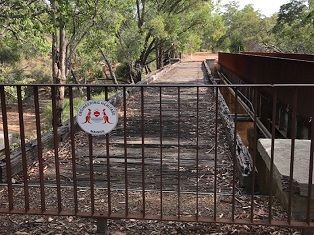
The Eastern Railway Deviation
The residents of the Swan River Colony became reliant on railway networks in the 19th century, to combat the large distances and open spaces in Western Australia. The Eastern Railway, which spanned Fremantle to York, was one of the major railroads built for this purpose and its construction was considered a major technical feat at the time.
The first stage of the line spanning Fremantle to Guildford was completed in 1881. Shortly after this, planning began on stage two of the line, which was supposed to cross the Darling Ranges by travelling parallel to the existing roadway at Greenmount Hill. However, the steep gradients and curves made this location less than ideal. Despite this, the work was completed in 1884, taking the railway out to Chidlow. Stage three of the project saw the railway extend to York — this was completed in 1885. In 1889 a branch was added to the railway line, so trains could travel south to Albany.
C.Y. O’Connor was appointed as Western Australia’s Engineer-in-Chief in 1891. The Eastern Railway had suffered many derailments and inefficiencies due to the challenging terrain of stage two, which meant the system was running at a loss. As a result, O’Connor commissioned a Victorian railway engineer to find an alternate route through the Darling Ranges. Construction on the new section began in 1893.
This major engineering project required large amounts of soil and rubble to be moved to construct embankments. Workers were also tasked with blasting and digging through granite to create Western Australia’s first railway tunnel. This was completed using only picks and shovels, dynamite and horsepower. The tunnel was an engineering feat in itself, and still remains the only rail tunnel of its type in Western Australia. Cut through 332 metres of solid granite, the two ends of the tunnel line up with remarkable precision, despite the engineers labouring under extreme difficulties.
The new section of the railway opened in 1896 and led to the creation of new settlements and industries in the Perth Hills area — such as timber cutting, quarrying and the cultivating of orchards. In 1897, another branch was added to the line, this time extending the railroad out to Kalgoorlie.
In 1961, the Western Australian government commissioned the construction of a new route, which would link Kwinana, Fremantle and Kalgoorlie. The completion of this new railway in 1966 meant the Eastern Railway Deviation closed. The tracks were removed in the 1970s and the route was turned into a heritage trail.
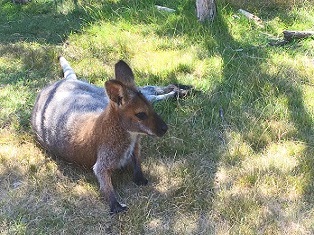
Many of Australia’s native wildlife species happily live in Perth. This includes kangaroos, wallabies, possums, black swans, quokkas, birdlife, reptiles and even koalas. Plus our oceans are home to much marine life such as dolphins, sea lions and tropical fish. Here is a list of the best places to go and spot our native wildlife.
Whiteman Park and Caversham Wildlife Park
Located 18 kilometres north-east of the Perth CBD, these wildlife parks aim to conserve and rehabilitate native fauna and flora. At Whiteman Park , there are eight different species of mammals including western grey kangaroos, southern brown bandicoots, black gloved wallabies, honey possums and short-billed echidnas. There are also over 100 species of birds —such as the wedge-tailed eagle and the black swan — and 32 reptile species.
Caversham Wildlife Park is a privately-owned native animal park situated inside Whiteman Park. It is home to 25 different mammals including dingos, koalas, kangaroos, possums, sugar gliders, Tasmanian devils, quokkas and wombats. You can also spot kookaburras, tawny frogmouths, black swans, emus and cassowaries, as well as a number of snakes and other reptiles.
Rottnest Island
Rottnest Island is an A-Class Reserve with a focus on environmental conservation. This means all flora, fauna and marine life are protected by law. The island measures 11 kilometres by 4.5 kilometres at its widest point — no private cars are allowed on the island, so the best way to get around is on a bicycle. There are also bus tours available. This is the only place in the world you will find quokkas living in the wild. There are also a number of frogs, reptiles and birds living on the island. Rottnest is home to some of the most beautiful bays and beaches, so it’s the perfect place to go snorkelling and spot native tropical fish and coral.
Penguin Island
Located just off the coast of Rockingham, Penguin Island and the surrounding waters are home to little penguins, Australian sea lions, dolphins and birdlife. There are 10 little penguins who have been orphaned or injured and cannot survive in the wild, living in the Discovery Centre on the island. Visitors can watch these penguins get fed by trained rangers. This is the best way to see penguins up close as they are often hunting during the day. Boat tours take visitors out to see the wildlife in the natural habitat. There is even an opportunity to swim with the wild dolphins!
With the weather cooling down as winter approaches Perth, it’s time to find some good indoor activities. Why not visit some of our museums? With subjects ranging from vintage video games and cricket, to trains and submarines, there’s something for everyone.
The Nostalgia Box Video Game Museum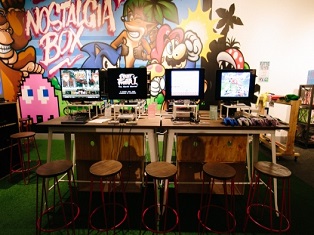
This museum showcases over 100 gaming consoles from the 1970s through to the 2000s. It takes you behind the scenes of the gaming world, by sharing stories about how each console was created. Plus it’s interactive – you can spend hours playing the games from your childhood, or trying out games you’ve never played before. It’s open Monday to Sunday from 10:30am-5pm and is located in Northbridge.
WACA Tours and Museum
The Western Australia Cricket Association has been the home of cricket in WA since 1893. It has a maximum capacity of 23,859 people, although there have been several occasions where crowds have packed out the stadium past this. Plus, the Guinness World Record for the highest basketball shot in the world was thrown from one of the floodlights. If you’re interested in the history of cricket in WA, the WACA runs tours every weekday. There is also an onsite museum featuring exhibits and memorabilia.
Maritime Museum
Showcasing many iconic vessels from Western Australia’s past, the Maritime Museum’s exhibitions represent Fremantle’s history as a coastal city and port. Ever wondered what life is like inside a submarine? There are daily tours inside the HMAS Ovens, an Oberon class submarine, where you can learn about our wartime past. There are a number of permanent exhibits displaying historic ships, the lifestyle of maritime travellers, and the history of Western Australia’s naval defence. The museum is open daily and is located in Fremantle.
Aviation Heritage Museum
This museum showcases the history of civilian and military aviation in Western Australia, by featuring over 30 aircrafts and thousands of artefacts. It also shares the stories of people who have contributed to this history, from pilots and engineers, to people who worked on the ground. Interactive exhibits allow visitors to experience the way aircrafts work. There are guided tours run by the museum’s volunteers – one of these allows you to experience what it’s like inside a restored Lancaster bomber from World War II. This museum is run by the Royal Australian Air Force Association along with assistance from community sponsors and visitors. It’s located in Bull Creek and is open daily.
Fremantle Prison
This maximum-security prison was continually in use for almost 140 years, until it was decommissioned in 1991. In 1992, it re-opened as tourist attraction to educate the public on the history and rich folklore of the punishment system. There are several tours which focus on different aspects of the prison’s past – from the convict era to its life as a maximum-security gaol – you can even explore the underground tunnels built by prisoners. Tours are run daily.
Art Gallery of Western Australia
Founded in 1895, this gallery showcases pieces from historic and contemporary Australian and Indigenous artists, as well as international art. There are also a number of special exhibitions which come to the gallery for a limited time, creating diversity in shared ideas. This museum is located in Northbridge and is open Wednesday to Monday.
If you’re looking for something to do in Perth, why not check out one of our marketplaces? From souvenirs and artisan handcrafts, to fresh produce, food trucks and live entertainment, there’s something happening in every corner of the metropolitan area.
Fremantle Markets 
The Fremantle Markets have been running for over 100 years and celebrate Western Australia’s culture and heritage. Open year-round on every Friday, Saturday, Sunday and Monday Public Holidays, these markets have everything from homewares, fashion, souvenirs and art, to coffee and fresh produce. Make sure you check out the food stalls, which serve numerous cuisines including Indian, Japanese, Turkish, German, vegan, barbecued meats, pastries, cupcakes and chocolates. There’s also live entertainment and events celebrating Australia’s native wildlife and Indigenous culture. These markets are located on the corner of Henderson Street and South Terrace in Fremantle.
Inglewood on Beaufort Monday Night Markets
This market features food trucks, marquees and shops along Beaufort Street – including restaurants, bars and cafes. With over 70 vendors participating in the event, there are countless cuisines on offer including: Japanese, Filipino, Malaysian, Mexican, Spanish, Argentinian, Brazilian, Moroccan, French, Thai, Italian and Vietnamese. There’s also live music and stores selling artisan gifts. This market runs every Monday evening until the end of April – so get in quick as there’s only a couple of weeks left!
Mount Hawthorn Hawkers Market
Featuring over 15 different food vendors and live music, this is the perfect way to wind down on a Friday evening. The cuisines range from Italian, Spanish and Turkish, to Argentinian, Dutch, Thai and Malaysian. These markets are located in Axford Park, Mount Hawthorn – they finish on April 27, so there are only two more dates left this season!
Mt Claremont Farmers Market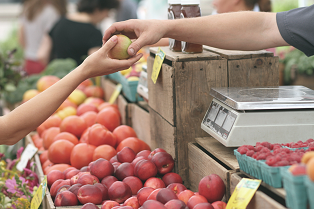
This farmers market is held at Mt Claremont Primary School every Saturday morning, no matter the weather. Start your weekend off with a breakfast from one of the many food stalls, including coffees, fresh juices, sausage sizzles, bacon and eggs, French pastries and crepes. Predominately a fresh food market, there’s an array of gourmet produce available, including fruit and vegetables, fish, meat, eggs, dairy and local condiments and olive oils.
Canning Vale Markets
This market runs every Sunday year-round and boasts over 300 stalls selling everything from furniture, tools, clothing, books, music, plants, and fresh produce. Make sure you visit the small selection of food stands to get your hands on hotdogs and fairy floss! They’re located on Bannister Road in Canning Vale.
A free week-long festival to celebrate young Perth artists kicks off this weekend. Presented by Propel Youth Arts, the Youth Week WA KickstART Festival will feature an extensive range of workshops, performances and exhibitions. These include a sketchbook exhibition, photography, comedy and exploratory music workshops, and poetry slams.
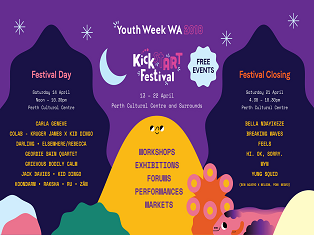
On Saturday 14 April, 10 hours of live music performances by WA acts will be held in the Perth Cultural Centre in Northbridge, along with food trucks, and free workshops and exhibitions. There will also be over fifty market stalls showcasing products from local artists and designers.
This year’s theme is Illuminate – Djoondal Djoomba, which relates to space and time. The Djoondal Djoomba reference comes from the ‘Carers of Everything’ Noongar Dreamtime story. This theme symbolises the bright futures of WA’s youth.
The KickstART Festival is now in its eighth year. It’s supported by the State Government of Western Australia, Lotterywest and the Metropolitan Redevelopment Authority.
Dates: Friday 13 April – Sunday 22 April
Location: Various locations in Northbridge, Elizabeth Quay, Perth and Curtin University.
